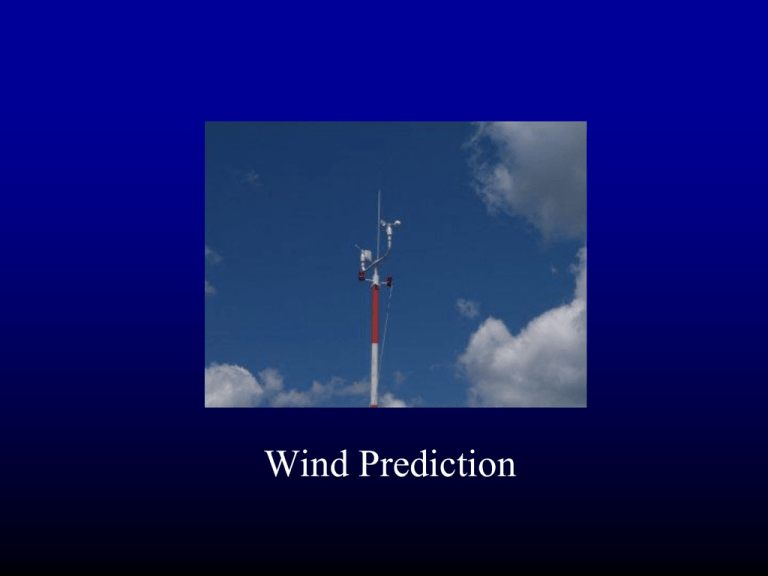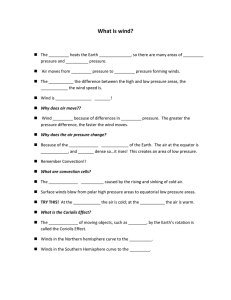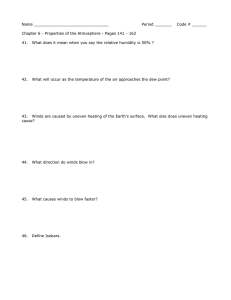Wind Prediction
advertisement

Wind Prediction NWS/FAA Wind Observations ASOS Sensors Have Been Changed from Three-cup to Acoustic Units Old ASOS Wind Sensor • The old ASOS wind sensor, the Belfort 2000, used rotating cups to measure wind speed and a vane to measure wind direction. • Over a two-minute period ASOS used 24 five-second averages to determine the two-minute average wind speed and direction. • The highest 5-second wind speed during the previous ten minutes was the gust. Gusts were only reported if there is a variation of 10 knots between peaks and lulls. • The highest instantaneous wind speed (gust) since the last routine report wss the peak wind. Problems With Old Wind Sensors New Acoustic Wind Sensor The New Wind Sensor • The new ASOS wind sensor, the Vaisala 425NWS, is a sonic anemometer. It has no moving parts and is designed to operate better in winter weather conditions. • As with the Belfort sensor, over a two-minute period, ASOS uses 24 five-second averages to determine the two-minute average wind speed and direction. But the highest threesecond running average speed is stored for gust and peak wind processing. • Most sites have switched to the new sensor. • The new sensor is responsive to short-term gusts. Can expect to see more gusts and peak winds reported with the new sensor. Wind Observations • Major issue is representativeness (e.g., in valley or behind a tree) • Surface winds are highly variable due to varying surface characteristics and obstacles. • Wind varies substantially with height and not all sensors are at similar elevations about the ground. Wind Gusts Wind Gusts Associated with Mixing of Higher Momentum From Aloft Gust Ratio Depends on Wind Speed Do Model Winds Include Gusts? NO! Wind Speed at the University of Washingon (Sampled every 5 seconds: reports 1 minute averages and highest 5 second wind gusts each minute ) MM5 Output Every Time Step from the 4-km Domain: Much Smoother! Wind Speed MM5 (or WRF) 4-km output every time step appears to have the temporal variability of approximately 15 minute-average winds Why? Winds are averaged spatially due to model resolution, grid-box averaging of some terms, and model numeric and explicit diffusion/smoothing. Thus, for verification we should compare model output to temporally averaged observations. Gust Guidance for the Forecaster • Gust ratio depends on wind speed and vertical stability • In a neutrally stable environment, forecasters often look for the max wind in the PBL as a measure of the max gust • There is software that does this as well. How do we do this for WRF? Danger of Using Model Output Directly • Lack of resolution..means larger scale models (e.g., GFS) can’t accurately define and predict local winds forced by mesoscale features…terrain, diurnal circulations. This is getting better. • Physics problems and particularly PBL parameterization issues. WRF and most other mesoscale models tend to overmix winds in the vertical…particularly under stable conditions-results in excessive winds. Winds generally too geostrophic • Large scale model errors…from poor initializations and other causes. Typical surface wind errors All winds 3 knot and more Use of Models • Today’s synoptic and mesoscale models are sufficiently realistic and accurate that is very hard to beat their wind forecasts aloft. The forecaster’s role is mainly in deciding which model to use and perhaps altering the timing, if phase errors are obvious. • At the surface, the models are getting better, but there are larger biases and other errors. Using SL Pressure For Surface Winds • Traditionally, an important tool of the wind forecaster was to start with the SLP pressure fields and deduce the surface (10-m) winds from it. • Lets review these relationships. Impact of Surface Drag Variations • Winds are often 50% to 300% stronger over water than land Stability and Vertical Momentum Mixing Wind Speed Up After WF Passage The Chanukah Eve Windstorm Stability Changes and Winds Momentum mixing: 12/17/06 Orographic barriers can greatly change the pressure and wind fields • Examples include mesoscale windward ridging and lee troughing. • Can greatly enhance or weaken the winds. Mesoscale Pressure and Wind Perturbations on Mesoscale Terrain Barriers • A controlling parameter is the Froude number: FR = U hN where U is the speed, h is the height of the barrier, and N is stability (Brunt-Vaisalla freq) • Large FR is associated with flow going up and over terrain (large vertical excursions), • Small FR with flow being deflected around (quasihorizontal flow) Strait of Juan de Fuca During the Coast Field Experiment Mesoscale Pressure Perturbations: Large Influence on Winds Sea Level Pressure February 13 1979: The Hood Canal Storm Very High Froude # Winds over 100 kts destroyed the Hood Canal Bridge Cost to replace: over 100 million dollars Stability Influences Topographic Blocking and Acceleration Gap Flow • In gaps through mountainous regions the flow is generally NOT geostrophc, but rather highly ageostrophic and downgradient, moving from high to low pressure. • Historically, forecasters have developed simple relationships between the wind speeds and pressure differences across the gaps in question. – Example: SEA office uses UIL-BLI gradient (westerly winds at exit= 10*delta p) Gap Flow 101 - Misleading the Next Generation! • The Venturi Effect is still used in some introductory texts to explain gap flow! It turns out that the strongest winds are generally not in the narrowest parts of mesoscale gaps, but in their exit regions Strait of Juan de Fuca is well known for its easterly gales in the gap exit region. Columbia Gorge Troutdale Most Simple Approach • 1-D horizontal momentum Equation: • Assume steady state, neglect Coriolis and friction and integrate: • This is simply a form of Bernoulli’s equation. Assuming steady state and no friction: Gap Flow 101 - Basics • Provides an upper limit to maximum speed at the end of the gap – Commonly used in work from the early 1980’s • E.g. Walter and Overland (1981), Reed (1981) – Oversimplification. – Produces winds that are too strong. • Gap winds are a boundary layer phenomena – Must account for drag (both surface drag and drag at the inversion) Gap Flow 101 – Adding Drag • Reintroduce friction (bulk aerodynamic form) • Shown to produce a much closer correlation to observed winds – E.g. Lackmann and Overland (1989), Mass et al (1995), Colle and Mass (1986), Bond and Stabeno (1998) Hydraulic Effects • There is another important features of many gap flow situations: hydraulic effects associated with changes in depth of the cold dense air (analogous to water) Hydraulic Effects Tend to Slow the Wind at the Entrance and Speed Up at the Exits Examples of Gap Flow The Columbia River Gorge Near Sea Level Gap On Border of WA and OR Troutdale 444.4 m grid spacing, Pass Height = 100 m Portland Troutdale Cascade Locks Vertical Structure • Strongest winds near exit • Hydraulic effects are important Fraser River NE Gap Flow Max Winds, 28 Dec. 1990 > 40 ms-1 Summary • Strongest winds tend to be in exit region because of hydraulic collapse and because of larger scale pressure gradient. • There can be some venturi acceleration in narrow regions…but that tends to be secondary. • High-resolution numerical models can do a very good job with fine-enough grid spacing. Diurnal Winds • • • • Sea breeze/land breeze Upslope and downslope winds And combinations of the above. Generally larger in the warm season. Sea Breeze Winds 2-minute average July-August winds along the Northwest coast. Summer Diurnal Winds Picture take in Sequim looking N Strong Regional Sea Breeze Winds During the Summer Land Breezes are Strongest in Locations with Warm Water • Weak in cold-water areas such as the northwest. • One exception: during arctic air outbreaks. Land Breeze example during a cold period. Interactions with larger scale flow • Strong onshore flow results in weak or nonexistent sea breeze • Weak to moderate offshore flow: strong sea breeze and sea breeze front • Strong offshore flow: weak sea breeze • Additive to flow parallel to the coast (e.g., southern Oregon) Sea Breeze Winds Along the Southern Oregon Coast: Interaction with synoptic scale flow • Gusts frequently reach 30-35 knots during the summer during the afternoon. • Very painful to stay on the beach! • Strong pressure gradient normal to the coast between the coastal thermal trough and cold upwelling water has a substantial impact. South North Southern Oregon Coast Near Brookings 2-minute average July-August winds along the Northwest coast. Slope Winds Fig. 7-11, p. 178 Mesoscale Models With Sufficent Resolution Can Do A Good Job on Diurnal Circulations Fovell (UCLA) Sea Breeze Simulations • http://www.atmos.ucla.edu/~fovell/ASother /mm5/LA_seabreeze.html Downslope Windstorms: strong winds on the lee side of mountains, generally associated with high amplitude mountain waves Enumclaw, WA Mountain Wave 101 Trapped MountainWaves Lee waves whose energy does not propagate vertically because of strong wind shear or low stability above are said to be "trapped.". These waves are typically at an altitude within a few thousand feet of the mountain ridge crest and turbulence is generally restricted to altitudes below 25,000 feet, particularly in rotors. No tilt and weaken with height aloft. Vertically Propagating Waves Vertically-propagating waves occur when waves become more amplified and tilt upwind with height. Tilting, amplified waves can cause aircraft to experience turbulence at very high altitudes. Clear air turbulence often occurs in the upper troposphere due to vertically-propagating waves. Such waves have been documented up to 200,000 feet and higher. Froude Number and Mountain Waves The Froude number expresses a ratio between the kinetic energy (wind speed) and the potential energy (stability times mountain height). • If the Froude number is equal to or slightly greater than 1, then there is the likelihood of mountain wave activity • If the Froude number is less than one, then the airflow is insufficient to carry the flow over the mountain and the flow is blocked. Lower probability of mountain waves. • If Froude number is much more than 1, airflow proceeds right over the mountain and down the other side, with no significant oscillations, but there can one high amplitude wave Trapped vs Vertically Propagating • A key parameter controlling the nature of mountain waves is the Scorer Parameter (l) l2 = N2 - d2U U2 U d z2 •k is the primary wavenumber of the terrain =2*pi/L , where L is the length scale of the terrain •k < l: vertically propagating, k >l trapped Result • Shorter wavelength waves tend to be trapped • Longer wavelengths tend to be vertically propagating. Downslope Windstorms Under the proper circumstances (e.g., a critical level aloft) the wave can amplify and break, resulting in a downslope windstorm To get a downslope windstorm, the energy from a mountain wave must be directed downward • Need some kind of cap or reflecting layer Critical Levels • A critical level occurs when the flow normal to the mountain barrier reverses. Critical Levels: Nature’s Reflector • Critical levels may be self-induced by wave breaking or result from the overall environmental flow. • Critical levels do not allow the vertically-propagating energy associated with mountain waves to continue upwards. Instead, that energy is deflected by the critical layer back towards the surface. • Consequently, critical levels can contribute to the development of, and/or the strengthening of, downslope windstorms. Stable Layer • A stable layer near crest level with less stable air above can act like a critical level. • Happens relatively frequently. What to look for for in a windstorm forecast • Strong winds approaching the barrier (and Froude number greater than one so air goes over the mountains). Winds should be within 45 degrees of normal to mountain crest. • Stable layer near crest level. Lesser stability aloft. • Critical level above the mountain barrier (to promote wave breaking). • The existence of weak vertical wind shear or reverse shear (winds decreasing with height) are more favorable than forward shear (winds increasing with height). • Strong downslope windstorms are often associated with large cross-barrier pressure gradients, but it is not clear whether those are cause or effect. Numerical Models and Downslope Windstorms • Until recently, criteria such as the above, used subjectively by forecasters, were the only approach. • During the past decade it is clear that high resolution numerical models (2-10 km grid spacing) are highly effective tools. • Demonstrated repeatedly here in the NW. Enumclaw, Washington “Place of evil spirits” Enumclaw Windstorm Pressure Pattern December 24, 1983 December 24, 1983 High-Resolution MM5 Simulations Do An Extremely Good Job of Predicting/Diagnosing Such Gap/Downslope Windstorm Hybrids December 18, 2010 Extreme Winds Associated with Strong Cyclones Over the Ocean Shapiro-Keyser Model of Oceanic Cyclones Warm Seclusion Stage Strongest Winds With Back-Bent Warm Front Inauguration Day Windstorm 1993 The Most Extreme of the Extreme: The Columbus Day Windstorm of 12 October 1962 Max Winds (mph) Columbus Day Storm 1962 Interaction with Terrain • Terrain-induced ageostrophic effects can be important • Thus, in terrain wind speeds can depend on the track and orientation of cyclones. Tracks for big windstorms over Puget Sound Strongest winds in Seattle when storm goes to the north of us • Ageostrophic acceleration down the pressure gradient. • When low west of us, winds are more geostrophic. • Ageostrophic winds can be larger with same pressure gradient. Terrain can enhance or reduce pressure gradients in locations and thus winds Why Strongest Winds Near the Central Coast? Mesoscale Pressure Perturbations: Large Influence on Winds Sea Level Pressure Local Effects (bluffs, barriers) can enhance winds substantially Columbus Day 1962: At Cape Blanco there were 150 mph with gusts to 179! Strongest winds on bluffs and windward slopes of coastal orography Isallobaric Wind: An ageostrophic wind associated with large pressure changes Isallobaric Wind Isallobaric wind blows toward max pressure falls Isallobaric wind Advection Schematic






